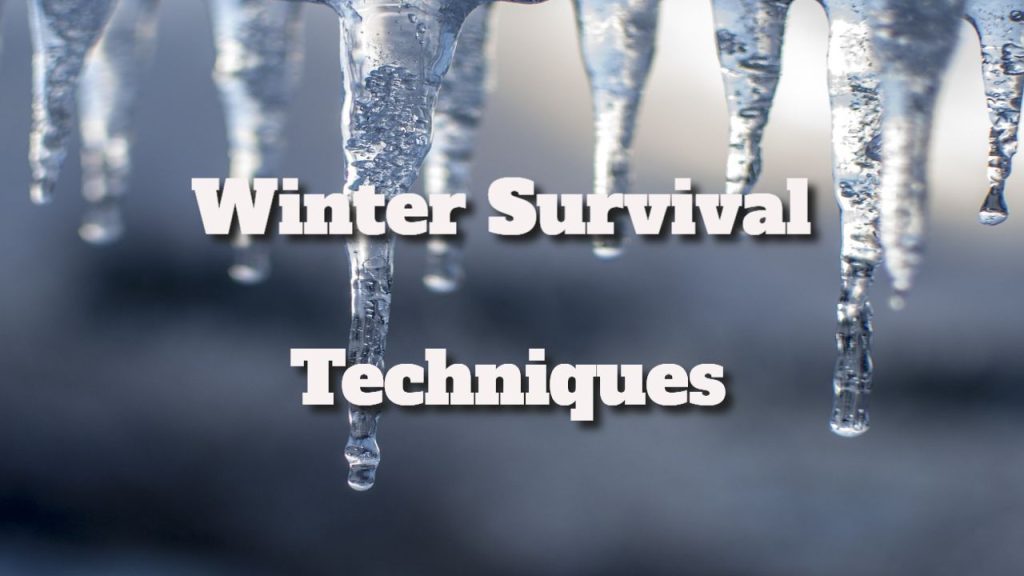The Finest Winter Survival Techniques
The Finest Winter Survival Techniques
The Finest Winter Survival Techniques: These suggestions will keep you alive if the weather turns bitterly cold.
We’ve been fighting the cold since the start of time, and we’ve had plenty of time to develop tactics for surviving in subzero temperatures.
We’ve also had plenty of time to create myths and misconceptions regarding winter survival. Before you have to sift fact from fiction the hard way – and become trapped in a winter storm or buried in an avalanche – here are some winter survival guidelines everyone should know.
You Are Doomed To Hypothermia If You Do Not Have The Proper Outdoor Clothes.
The appropriate gear can make a tremendous difference in comfort and survival in the wild outdoors. If the weather changes unexpectedly and your clothing is insufficient, you should resort to one of the oldest survival techniques.
Stuff your garments with natural plant insulation, as our Stone Age forefathers did. Scratching up foliage and stuffing it into your garments creates a dead air space and feels warmer.
Grass, moss, ferns, leaves, pine needles, and other alive and dead plant materials can be stuffed inside pant legs and shirts.
Don’t be concerned about the materials being unpleasant or harbouring bugs; they will be. This isn’t about being comfortable. You’ll feel and look ridiculous, but it’ll be warmer. It’s a fair trade-off if it saves you from getting cold.

Frostbite Treatment
Rubbing your hands together when chilly is natural, but this isn’t recommended if your tissues are frostbitten. Rubbing frozen skin together will not produce any beneficial heat.
Worse, touching ice crystal-covered skin will cause more tissue injury.
When you move these sharp ice spikes, they harpoon more tissue and cause more harm than if you just left the skin alone. Gentle rewarming is the best treatment for this situation (assuming additional frost damage can be avoided).
Begin by identifying the issue. Light frostbite appears dull and waxy. Deeper frostbite is pale and stiff. Begin rewarming using pain medication (frostbite is painful once thawed).
Ibuprofen is an effective pain reliever that should be used immediately.
Warm the frostbitten tissue by placing it on warm skin or in warm water. The final measures are to keep the thawed tissue from freezing again and to monitor the person for hypothermia and shock.
Winter Can Cause Dehydration.
The winter air is dry in many places. Because sweat evaporates fast (or is absorbed by garments), you may not perceive any sweat, but it is a fallacy to assume that “no sweat” means “no dehydration.”
Your skin reveals the truth. Dry, cracked skin on hands, feet, and lips indicates the drying effects of winter’s low humidity. If you pay attention to your water balance, you can avoid this painful side effect of dehydration.
The simplest way to do this is to monitor your urine production. You are dehydrated if you are not creating “yellow snow” every several hours.
Urine is the best hydration indication since it considers your activity level, humidity, injury, illness, and many other factors.
You don’t need to worry about dehydration if you drink enough to urinate at a typical rate and frequency.
How to Survive an Avalanche
Flatlanders who aren’t travelling shouldn’t be concerned, but it’s one of the scariest risks in snowy mountains for people moving into an avalanche zone. Being caught in an avalanche may appear hopeless, but a little preparation and awareness can make all the difference. Here are three items that can come in handy on snowy slopes.
Make sure someone is aware that you are present. A responsible person (or two) should know where you’re going, which road to take, and when you’ll be back. This is solid advice in avalanche zones and a sound strategy in general.
Keep an avalanche transceiver on hand.
This device can route searches to you. Before you go out, learn how to use and transport it.
Swim to save your life.
Flowing snow does not move in the same way as water does, although it moves similarly. If an avalanche begins, abandon your equipment (you can’t swim while wearing skis, snowshoes, or a snowmobile).
Attempt to “swim” across the snow, avoiding solid things like trees and boulders. Push, kick, and swim’ as hard as possible to stay on the snow’s surface. If you can’t stay on top, keep near the surface and cover your face with your hands to receive some air.
Alcohol Consumption Causes A Decrease In Body Temperature.
You’ve probably seen a St. Bernard carrying a tiny whisky barrel around its neck. This classic artwork depicts a true story.
These rescue canines occasionally carried alcoholic beverages, but that doesn’t suggest drinking alcohol in extreme cold is a wise choice. The belief that a drink of alcohol can warm you up is false.
Here’s a helpful winter survival tip: Because it dulls the discomfort of cold exposure and causes a flushed feeling as more blood flows to the skin, alcohol can make you feel warm.
However, the diversion of blood flow away from the body’s core, and the “feeling” of being warmer is not as essential as the actual rise in body temperature.
This illusory warmth created by more blood reaching the surface cools your body down more quickly. Instead of drinking alcohol, drink something warm, such as hot chocolate, which gives both calories and warmth in a cold situation.
Thrive In Cold Water.
An unlucky outdoor enthusiast falls into frigid water and sinks to the bottom. Divers may take some time to locate the victim in the murky water.
The perilously cold water can induce “suspended animation” in a drowning victim. Brain injury is postponed, and cell oxygen requirements are decreased by delaying and cooling all systems.
After being submerged in near-freezing water for up to 40 minutes, victims have been retrieved and revived. Never halt resuscitation efforts in such a case until the body has fully warmed up and is still not responding to therapy.
Avoid Overheating With Intense Heat.
Hot baths and saunas are famous in ski resorts and cold locations, and while it may appear to be a good idea to throw someone in a hot tub to warm them up again, this form of heat exposure is not the appropriate treatment for hypothermia.
Immersion in hot water is not only uncomfortable for the victim’s skin; it can also cause shock or even a heart attack. Active external rewarming performed by professionals is the correct prescription.
If this is not possible, surround the person with warm things. Hot water bottles, for example, can be placed in the groyne, armpits, and around the neck. Never immerse the sufferer in a hot bath, use a steam bath, or expose them to excessive heat in any other way.
It Is Only Sometimes Possible To Eat What The Animals Eat.
A few stray berries on a cold landscape can appear to be a feast for a hungry survival. You may not know who they are, but the animals eat them.
Is this to say they’re safe to eat? Certainly not. Other species do not provide a reliable model for human foraging. Squirrels and deer routinely consume wild plants that would harm humans if they ingested.
Birds are an even poorer human role model. Their digestive processes are different from mammals, and they can comfortably consume a wide variety of plants that would both nourish and kill us.
If you want to know which wild plants are edible to people and which are deadly, you must investigate closely and avoid shortcuts.
It’s Dangerous To Get Your Truck Stranded In The Snow.
It’s a double-edged sword when your vehicle becomes stuck in the snow during a snowstorm. On the one hand, at least you’re safe from the storm. On the other hand, this defence has significant drawbacks.
All much metal creates a very frigid shelter, sucking the body heat out of the cabin at subzero temperatures. The only alternative for heating is to leave the engine running, but this can be a disastrous mistake.
If you can keep the tailpipe open, starting the vehicle using the heater can be helpful.
When a vehicle’s tailpipe becomes buried by snow, slush, mud, or water, exhaust fumes can back up into the vehicle’s interior, causing carbon monoxide poisoning and death.
Keeping vehicle engines running during snowstorms has rescued individuals from hypothermia but has also lost people’s lives.
Starting a Fire in the Snow
You’ve most likely attempted to make a fire in the snow during your outdoor escapades. If you tried, it all began usually. The fuel burnt, and the kindling caught fire.
However, as soon as the embers began to develop, they plummeted into the snow and were destroyed with a hiss. Then you discover that a fire directly on snow will only last for a while.
There are, thankfully, other options. If there is only a light covering of snow, dig down to the frozen earth and construct your fire there. If the snow is too deep, attempt option two: build a fire platform on the snow.
The simplest solution is constructing a wooden “raft” on top of the snow. This raft can be constructed using wet, rotten wood, freshly cut live wood, or a combination.
Place the pieces closely together so that there are no gaps through which the embers can fall into the snow. Start a fire on this raft like you would on the land.
It can burn for an hour or many hours, depending on the moisture content of the wooden raft. If necessary, it can also be changed.
Winter Survival Advice – What To Do And What Not To Do
Make finding refuge your primary survival aim. As much as feasible, use insulation and supplementary heat sources. This may entail tearing up your car’s upholstery for insulation or placing hot pebbles in its floorboards to keep it warm. Do whatever you believe is required to survive.
Do not abandon your shelter. Snow, fog, darkness, and other elements can make finding your shelter difficult after leaving it to signal or forage. Mark the shelter with an improvised flag, anything reflecting or whatever other signal you have. Not only will you have an easier time finding your shelter, but your rescuers will also have a higher chance of discovering it.
DO NOT sleep directly on the snow or ice. It would help to have something underneath you, even in a snow cave. Gather some evergreen branches, tree bark, leaves, or anything else that can be a barrier between you and the chilly surfaces.
Keep hydrated. The colour and amount of urine you urinate are the best indicators of your hydration level. You are highly dehydrated if you haven’t urinated in several hours and the colour is dark yellow or amber.
Keep ice and snow out of your mouth. Even though it’s safe to drink, you shouldn’t ever take it in its frozen solid form. This will swiftly cool your core and cause hypothermia. Instead, put the snow or ice in a bottle under your coat, not on your skin. The heat from your body beneath your garment will liquefy the frozen material into water, making it safe to swallow.
Take kindling and numerous ignition sources with you when travelling in chilly weather. Lighters, matches, and matches are all viable options. Use cotton balls dipped in Vaseline or fire starter packages to light cold, damp wood.
Do Not Try to Start a Fire in a Windy Area or on the Snow. These are two disastrous recipes. Build windbreaks if you must build a fire outside. If you build a fire over snow, cut some green wood to make a fire platform.


